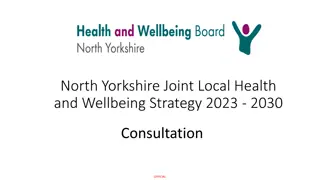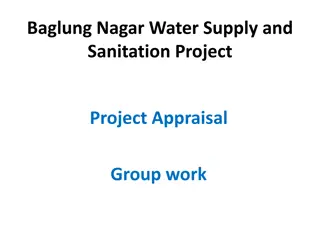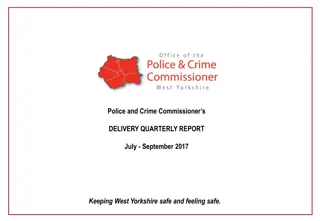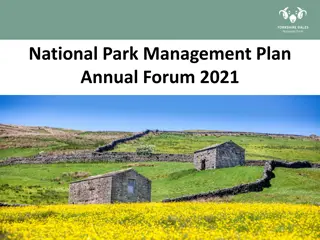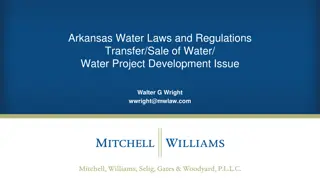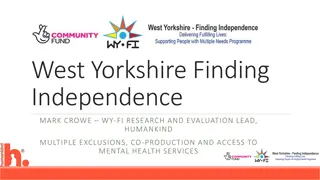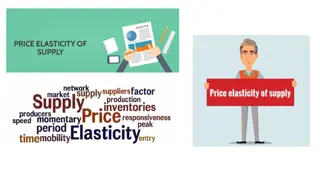Improving Water Quality and Supply Efficiency for Yorkshire Water Customers
Yorkshire Water aims to enhance water quality and reduce interruptions in supply for its customers. By investing in maintenance and modernization of water mains, they seek to address issues related to the look, taste, and smell of tap water, as well as minimize unplanned interruptions to the water supply. Through proactive measures and targeted investments, Yorkshire Water strives to provide a reliable and safe water service to households in the region.
Download Presentation

Please find below an Image/Link to download the presentation.
The content on the website is provided AS IS for your information and personal use only. It may not be sold, licensed, or shared on other websites without obtaining consent from the author.If you encounter any issues during the download, it is possible that the publisher has removed the file from their server.
You are allowed to download the files provided on this website for personal or commercial use, subject to the condition that they are used lawfully. All files are the property of their respective owners.
The content on the website is provided AS IS for your information and personal use only. It may not be sold, licensed, or shared on other websites without obtaining consent from the author.
E N D
Presentation Transcript
Attribute A version 1 Drinking Water Quality The issue: The number of times our customers contact us each year because of issues with the look, taste or smell of their water. Current situation: The number of contacts per 10,000 people in 2021/22 was 10.9 What could change: More investment, for example, in additional flushing of water mains and renewing or relining cast iron mains would help us reduce the amount of colour and smell in the water some of our customers receive.
Attribute A version 2 The look, taste and smell of your tap water The issue: Every year some customers experience an unexpected change in the colour (normally light brown) and / or the taste or smell of their water supply (normally a chlorine smell). The water is safe to drink and can be used for bathing and in washing machines and dishwashers. The change usually lasts for around 24 hours and could happen at any time. Current situation: Each year around 1 in 1,000 households in the region contact Yorkshire Water about the look, taste or smell of their drinking water. What could change: More investment, for example, in maintenance of the network or modernising the mains pipes would help reduce the number of times customers experience these issues.
Attribute A - Version 1 Title The issue: Current situation: What could change: Attribute A - Version 2 Title The issue: Current situation: What could change:
Attribute B version 1 Unplanned Interruptions to Supply The issue: Your water supply stops working without warning, affecting all taps, toilets, dishwashers etc. and lasts for 3 to 6 hours. Current situation: The number of properties that are affected with a 3-6 hour unplanned interruption in 2021/22 was 45,501. What could change: More investment would allow us to reduce the number of sudden interruptions customers experience by undertaking more proactive maintenance and replacement of ageing clean water network assets; it would allow us to better manage water pressure and better respond to company and customer identified mains failures.
Attribute B version 2 Reducing the chance of a lengthy unplanned interruptions to the water supply The issue: Every year a certain number of households in the Yorkshire Water region experience their water supply being cut-off for 3 to 6 hours due to unplanned interruptions such as burst pipes. During an interruption Yorkshire Water would deliver bottled water to vulnerable people. Current situation: The number of properties in 2021/22 who experienced their water being cut-off during an unplanned interruption between 3 to 6 hours long is roughly 2% or 2 in 100 properties. What could change: More investment for example replacing old and damaged pipes, using technology to identify water bursts, repairing bursts more quickly and undertaking more ongoing planned maintenance work would reduce the chances of any lengthy unplanned interruptions happening.
Attribute B- Version 1 Title The issue: Current situation: What could change: Attribute B - Version 2 Title The issue: Current situation: What could change:
Attribute C version 1 Leakage The issue: Millions of litres of water are lost from the Yorkshire Water network and customer properties as a result of leaks. Current situation:The amount of water lost between our treatment works and our customers taps in 2021/22 was 283.1 million litres of water per day, this is approximately 22% of all the water Yorkshire Water produce. What could change: More investment would allow us to employ more people i.e. more leakage inspectors will mean finding more leaks and more network protection colleagues to fix leaks faster. Investment would also help fund innovative projects to helps find leaks which are currently undetectable with current technology and equipment.
Attribute C version 2 Reducing water lost through leakage The issue: Leaks in the pipe network causes clean treated water to be lost before it reaches customers taps. Current situation: Last year 22% of water was lost through leaks in the network, this is 283.1 million litres of water per day. This is the equivalent of supplying the population of Leeds and York each day. What could change: More investment would mean old pipes could be replaced quicker and new smart technology could be adopted to find and fix leaks sooner. This would mean less water is lost to leakage.
Attribute C - Version 1 Title The issue: Current situation: What could change: Attribute C - Version 2 Title The issue: Current situation: What could change:
Attribute D version 1 Per Capita Consumption The issue: This is the average amount of water each person uses in their household each day. Current situation: In 2021/22 the average amount of water each person used in their home is 131.5 litres of water per day. What could change: More investment would allow us to do more targeted customer messaging on water use reduction and benefits of this. It would also allow us to encourage more customers to have a water meter fitted. We could also fit more meters when properties exchange hands.
Attribute D version 2 Water usage The issue: Water costs money and energy to clean, process and deliver to customers properties. It should be used wisely and not wasted. Current situation: Every person in Yorkshire uses an average of 131.5 litres of water per day for drinking, cooking, washing, cleaning, flushing the loo, watering plants etc. What could change: More investment would allow us to do more communications on how customers can save water, provide more water saving advice and devices, encourage more customers to switch to having a water meter so they can better monitor their water usage.
Attribute D - Version 1 Title The issue: Current situation: What could change: Attribute D - Version 2 Title The issue: Current situation: What could change:
Attribute E version 1 Internal Sewer flooding The issue: Sometimes our network can fail and sewage can flood the inside of homes or business. Current situation: The total number of internal sewer flooding incidents per 10,000 sewer connections in 2021/22 was 2.83 What could change: More investment would allow us to increase the proactive maintenance and replacement of ageing wastewater network assets; install monitoring devices and improve mapping of sewers; increase targeted customer messaging on avoiding disposal of items down drains and toilets; better respond to reports of sewer blockages and collapses; increase jetting of sewers; management and control of rainfall induced flows into the sewer network.
Attribute E version 2 An effective sewerage system Sewage flooding inside properties The issue: Flooding from the sewer can get inside homes and businesses, affecting living areas, giving off a foul smell, damaging floors, walls and furniture. This can be distressing for those affected and harmful to the home environment. Current situation: Around 1 in 3,534 of properties each year experience an internal flooding incident defined as the escape of water from the sewerage system which enters a building. What could change: Investing more in extra sewerage capacity (infrastructure), technology to identify and respond to issues more quickly and education (working with customers to reduce sewer blockages) will reduce the risk of sewage flooding.
Attribute E - Version 1 Title The issue: Current situation: What could change: Attribute E - Version 2 Title The issue: Current situation: What could change:
Attribute F version 1 External Sewer flooding The issue: External sewer flooding happens when sewage escapes from Yorkshire Water pipes and spills on to the ground outside your property or a local area such as a public park giving off a foul smell, and which could cause damage. Current situation: The total number of external sewer flooding incidents in 2021/22 was 4,578. What could change: More investment would allow us to increase the proactive maintenance and replacement of ageing wastewater network assets; install monitoring devices and improve mapping of sewers; increase targeted customer messaging on avoiding disposal of items down drains and toilets; better respond to reports of sewer blockages and collapses; increase jetting of sewers; management and control of rainfall induced flows into the sewer network.
Attribute F version 2 Sewage flooding outside properties The issue: Some customers experience sewage escaping from the pipes onto the outside of their property such as in their garden. This is caused by blocked or burst pipes, which can be distressing for them and harmful to the environment. Current situation: Just over 1 in 524 properties in the Yorkshire Water region experienced sewage escaping from the pipes onto the outside of their property each year. What could change: Investing more in infrastructure, technology and education will help reduce the chances of external sewage flooding happening.
Attribute F - Version 1 Title The issue: Current situation: What could change: Attribute F - Version 2 Title The issue: Current situation: What could change:
Attribute G version 1 Length of River Improved The issue: The quality of some of the waste water we treat and put back in to the environment (as well as other factors outside of Yorkshire Water s control) can have some negative effects on habitats for fish and wildlife, and can lead to algae (green slime) in the river water. Yorkshire Water continuously work to improve their impact on the 6000km rivers of Yorkshire. Current situation: In 2021/22 the cumulative length of river water that was improved as a consequence of improvement schemes was 50.08km, which met the target set for last year. What could change: More investment would allow us to introduce more schemes which improve more kilometres of river water each year e.g. upgrading equipment at treatment works to treat waste water effluent to a higher standard e.g. with UV, biological phosphorous removal, or chemical treatment.
Attribute G version 2 River water quality The issue: Chemicals and fertilisers from agriculture, pollution from industry and discharges from wastewater treatment works can all impact on the quality of river water in the region. Current situation: The levels of damaging chemicals in some places are much higher than they should be. Last year Yorkshire Water completed a number of schemes which improved 50.08km of the rivers in Yorkshire, meeting the target set. What could change:Although some of this is out of Yorkshire Water s control, greater investment would result in more actions to improve the river water quality. This would benefit nature and wildlife by reducing the levels of damaging chemicals in the water.
Attribute G - Version 1 Title The issue: Current situation: What could change: Attribute G - Version 2 Title The issue: Current situation: What could change:
Attribute H version 1 Bathing Water Quality The issue: Most but not all bathing waters meet or exceed the European Union Bathing Water Directive for water quality requirements. You could still swim in the sea, but there would be a small increase in the chance that you might get ill if you swallowed some water. Current situation: The total number of bathing waters which meet or exceed standards is 16 out of 18. What could change: More investment would allow us to do more partnership working to ensure the run off from farms is of the highest standard. We can also further invest in our coastal treatment works to ensure they are run at optimal performance, treat effluent to an even higher standard and further reduce the risk of failures.
Attribute H version 2 Sea Water Quality at Yorkshire s Beaches The issue: The sea water is not always rated as excellent, based on the tests regularly undertaken by the Environment Agency at every beach along the Yorkshire Coast. Current situation: Out of the 18 beaches the quality of the sea water was rated by the Environment Agency as being excellent at 7 of them, good at 9 and the minimum status of sufficient at 2 none were rated poor. What could change: Further investment would help reduce pollution incidents from sewerage treatment plants, reduce the impacts caused by agriculture and industry, all of which would improve the quality of the sea water on Yorkshire s beaches.
Attribute H - Version 1 Title The issue: Current situation: What could change: Attribute H - Version 2 Title The issue: Current situation: What could change:
Attribute I version 1 Pollution Incidents The issue:This is where Yorkshire Water s sewerage system causes pollution when unexpected sewage escapes into rivers and streams. This includes incidents where sewage enter watercourses, causing an environmental minor impact which can have minimal effects on water quality e.g. having a small loss of larvae or fish species such as stickleback. Current situation: The number of minor pollution incidents caused by our wastewater assets from January to December 2021 was 126. What could change: More investment would allow us to do more of the activity that prevents pollution from happening i.e. flushing sewers, recruiting more network protection colleagues, finding sewer defects and fixing them before they become a problem.
Attribute I version 2 Wastewater pollution The issue: The environment is affected by a small number of wastewater pollution incidents a year. Current situation: Last year there were 126 minor pollution incidents in the Yorkshire Water area. What could change: Greater investment in areas such as more maintenance, repair and monitoring of sewers, along with educating customers about what to and not to put down the drain, will reduce the number of these incidents.
Attribute I - Version 1 Title The issue: Current situation: What could change: Attribute I - Version 2 Title The issue: Current situation: What could change:
Attribute J version 1 Low Pressure The issue: When water pressure is low, it would take longer to fill a bath. Low pressure in customers properties is caused by a number of factors such as bursts or perhaps a new housing development being added to the network, we work hard on maintaining pressure for all our customers every day. Current situation: The total number of registered properties which, at the end of the year, have received, and are likely to continue to receive, a pressure or flow below the standard level is 4. This number would have fluctuated throughout the year. What could change: Maintaining and improving pressure reduces the risk of supply issues, more investment would allow us to do more work on our network helping to avoid low pressure but also future problems.
Attribute J version 2 Low Water Pressure The issue: Every year some households experience problems with the force and volume that water comes out of their taps. When water pressure is low, it comes out of the tap as a trickle. Current situation: Last year Yorkshire Water helped around 50 customers resolve problems they were experiencing with low water pressure, bringing the current number of customers who have received, and are likely to continue to receive below standard water pressure to 4. What could change: More investment would allow Yorkshire Water to invest more in the infrastructure and network which will mean fewer customers experiencing problems that cause short periods of low water pressure.
Attribute J - Version 1 Title The issue: Current situation: What could change: Attribute J - Version 2 Title The issue: Current situation: What could change:





